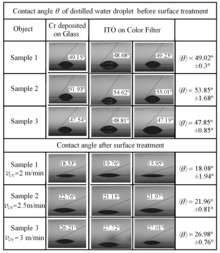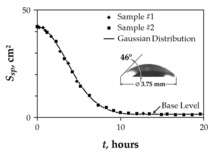Plasma cleaning
Plasma cleaning involves the removal of impurities and contaminants from surfaces through the use of an energetic plasma or Dielectric barrier discharge (DBD) plasma created from gaseous species. Gases such as argon and oxygen, as well as mixtures such as air and hydrogen/nitrogen are used. The plasma is created by using high frequency voltages (typically kHz to >MHz) to ionise the low pressure gas (typically around 1/1000 atmospheric pressure), although atmospheric pressure plasmas are now also common.[1]
Methods
In plasma, gas atoms are excited to higher energy states and also ionized. As the atoms and molecules 'relax' to their normal, lower energy states they release a photon of light, this results in the characteristic “glow” or light associated with plasma. Different gases give different colors. For example, oxygen plasma emits a light blue color.
A plasma’s activated species include atoms, molecules, ions, electrons, free radicals, metastables, and photons in the short wave ultraviolet (vacuum UV, or VUV for short) range. This 'soup', which incidentally is around room temperature, then interacts with any surface placed in the plasma.
If the gas used is oxygen, the plasma is an effective, economical, environmentally safe method for critical cleaning. The VUV energy is very effective in the breaking of most organic bonds (i.e., C–H, C–C, C=C, C–O, and C–N) of surface contaminants. This helps to break apart high molecular weight contaminants. A second cleaning action is carried out by the oxygen species created in the plasma (O2+, O2−, O3, O, O+, O−, ionised ozone, metastable excited oxygen, and free electrons).[2] These species react with organic contaminants to form H2O, CO, CO2, and lower molecular weight hydrocarbons. These compounds have relatively high vapour pressures (means they escapes to space easily) and are evacuated from the chamber during processing. The resulting surface is ultra-clean. In Fig. 2, a relative content of carbon over material depth is shown before and after cleaning with excited oxygen [1].

If the part to be treated consists of easily oxidized materials such as silver or copper, inert gases such as argon or helium are used instead. The plasma activated atoms and ions behave like a molecular sandblast and can break down organic contaminants. These contaminants are again vapourised and evacuated from the chamber during processing.
Most of these by-products are small quantities of gases such as carbon dioxide and water vapor with trace amounts of carbon monoxide and other hydrocarbons.
Whether or not organic removal is complete can be assessed with contact angle measurements. When an organic contaminant is present, the contact angle of water with the device will be high. After the removal of the contaminant, the contact angle will be reduced to that characteristic of contact with the pure substrate.
If a surface to be treated is coated with a patterned conductive layer (metal, ITO) deposited on it, treatment by a direct contact with plasma (capable for contraction to microarcs) could be destructive. In this case, cleaning by neutral atoms excited in plasma to metastable state can be applied.[3] Results of the same applications to surfaces of glass samples coated with Cr and ITO layers are shown in Fig. 3.

After treatment, the contact angle of a water droplet is decreased becoming less than its value on the untreated surface. In Fig. 4, the relaxation curve for droplet footprint is shown for glass sample. A photograph of the same droplet on the untreated surface is shown in Fig. 4 inset. Surface relaxation time corresponding to a data shown in Fig. 4 is about 4 hours.
Plasma Ashing is the process in which plasma cleaning is performed for the sole purpose of removing carbon. Plasma Ashing is always done with O2 gas.[4]

References
- ↑ Evgeny V. Shun’ko & Veniamin V. Belkin. "Cleaning Properties of atomic oxygen excited to metastable state 2s22p4(1S0)". J. Appl. Phys. 102: 083304–1–14. Bibcode:2007JAP...102h3304S. doi:10.1063/1.2794857.
- ↑ A. Pizzi; K. L. Mittal (2003). Handbook of Adhesive Technology, Revised and Expanded (2, illustrated, revised ed.). CRC Press. p. 1036. ISBN 978-0824709860.
- ↑ Evgeny V. Shun’ko & Veniamin V. Belkin. "Treatment Surfaces with Atomic Oxygen Excited in Dielectric Barrier Discharge Plasma of O2 Admixed to N2". AIP Advances. 2: 022157–24. Bibcode:2012AIPA....2b2157S. doi:10.1063/1.4732120.
- ↑ Plasma Treatment Basics - http://www.plasmaetch.com/plasma-treatment-basics.php
External links
Cleaning Plasma and where it is used: http://tantec.com/cleaning-plasma-and-where-is-it-used.html